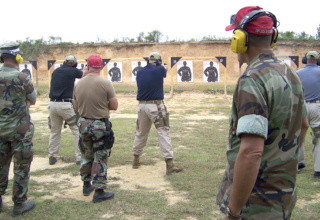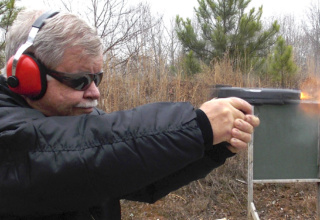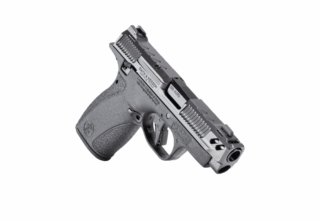While the training never stops even for experienced shooters, beginners should get to class right now. Here’s what you need to know in choosing a firearm training course and what to expect when you get there.
by Frank Melloni; photography by Barbara Melloni
If you are one of the eight million new gun owners in this country, welcome! We congratulate you for navigating the murky waters that comprise selecting and purchasing your first firearm. If you are reading this, then you likely have found out that those same waters flow straight into the massive sea that is firearms training.
Instructors are plentiful, and there is a plethora of options out there to help start off on the right foot, but you are likely wondering which training opportunities are right for you. After assisting more than 25,000 students pick out their first (or next) training session at Renaissance Firearms Instruction, I would like to share my experience to help you find the right course, prepare for it, and to get the most out of your range day.
First, research your instructor and the company. Sadly, it doesn’t take more than a weekend to earn an instructor’s certificate. Today, many semi-experienced shooters are teaching just because there is a buck to be made doing so; therefore, it is highly possible that you might be learning from somebody with not much more experience than you. Take a deep dive into your potential instructor’s shooting credentials and try to find third-party reviews of their work. Be sure to research the entity that certified them as well. In this industry, it isn’t uncommon for the parent company of an organization to do the certifying, which is essentially the equivalent of, “I’m an instructor because my mommy says so.” While that is not a disqualifier, I always recommend that you learn from an instructor who has credentials from somewhere on the outside.
After you have picked a training company, you want to find the best course for your specific needs by reviewing the course outline. A good instruction company will publicly disclose the course syllabus; great companies will provide videos that contain actual course footage to thoroughly explain the scope of the training session. Your job is to familiarize yourself with the material and then decide if it fits your needs BEFORE registering.
Did you buy a shotgun for home defense? Then maybe the NRA Rifle course isn’t your best option. It also pays to understand that you typically won’t learn everything that you need from one course alone. So, before dismissing one course or another for exclusion, be sure the material that you seek isn’t covered in greater detail in a “level two” type course.
Experienced instructors take this approach to ensure that students have a solid foundation in the basics before introducing things like dynamic movements and drills that involve advanced gun handling—particularly with loaded firearms. A few times a week, we get a phone call that goes something to the tune of, “I just bought a handgun for home defense. Can you help me learn the basics of room clearing?” While we understand the concern and line of thought, that individual is going to be next to useless in a firefight unless they first learn how to hold the gun, load it, and take the safety off.
Preparation for the course is going to call a lot of areas into question. Just like a syllabus, a good instruction course will have both a required and recommended gear list. Each list will vary in length and complexity, depending on how involved the course is. Here is an example of both ends of the spectrum:
Generally speaking, the more advanced the course, the greater the gear list. You are going to want to look this list over as soon as possible to allow time for procurement, particularly if you need to bring your own ammo or need a hard-to-find gun part. If your course doesn’t involve carrying everything on your back, use the “better to have it and not need it” motto and bring everything that you typically use on the range, even if you must leave it in your trunk. Aside from shooting gear, be sure to bring comfort items like a chair, sunscreen (if the course is outside), water, and if necessary, lunch. If there is a piece of gear that you don’t have or you have questions about, be sure to reach out to your instructor as soon as possible.
Once you have all your gear together, it pays to know what to expect to help you determine if learning is taking place or if you are attending a “spray and pray” party. While no two courses are the same, they should all include these learning modules:
- Group verbal instruction.
- Demonstration of the material being covered.
- Group live-fire exercises.
- One-on-one attention.
- Information on what comes next.
Group instruction is essential for training. Often, we receive requests for private training, and while we do offer it and it does have its place, it often is not the best way to start out.
Why? Well, if you are exceptionally new, then you simply don’t yet know the questions that need to be asked. In other words, you don’t know what you don’t know. In a group setting, though, you get the opportunity to pool brainpower and one of your peers will invariably ask something that you have yet to consider.
Group courses also get you accustomed to having other people on the firing line, which is going to best represent the typical practice environment for most new gun owners. The second is a demonstration of what is to be learned. If you have already vetted your instructor (highly recommended), then this is the time for you to see if they are currently practicing and are experienced in the subject matter beyond mere words.
After hearing about it and seeing it, next comes the time to try it yourself. Group live-fire allows each attendee to explore a bit on their own while instructors offer general advice and concentrate on supervising the firing line. This is critical because it provides the opportunity to make mistakes, which, in turn provides the catalyst to learn.
Once the group is settled in and working towards its goals, you want to see your instructor(s) checking on each student to help them set the groundwork to resolve each of their respective problems. Perhaps one student is struggling with stance and the other with grip. This approach and environment help each participant grow by pinpointing and correcting their unique issues.
After the course has concluded, you should leave knowing your next steps and how to take them. A good training course will recommend the best follow-up courses and explain why you may want to enroll, even if they are courses that the company doesn’t teach. You also want to know how to join local gun clubs, or which public ranges are available for immediate use. It’s also not a bad idea to inquire where and when matches are conducted. Even if you don’t have plans of competing, much can be learned just from spending time as a spectator at these organized events.
The best part about firearms training is that you can do it at your own pace. Although I recommend getting some initial training under your belt immediately upon purchasing your first gun, the rest can be spread out over a lifetime. Good instructors are also taking courses themselves, which testifies to something that I deeply believe in, and that is that you will never learn it all from one person. All our instructors still take training courses and, often, I’ll even take a course with somebody who teaches something that I specialize in. In just about every instance, I learn something new or, at the very least, learn another way to teach something that is important to get across to new shooters.
Above all, never allow yourself to enter the mindset of, “I know all of this already.” It’s best to remain an eternal student and never stop growing.


















